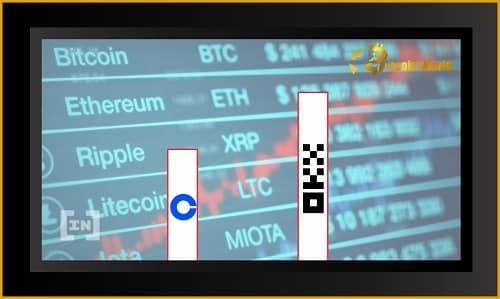Cryptocurrency markets can be as volatile as they are exciting, and March 2022 was a month that proved just that. While NFTs and DEXs also felt the chill, even giants like Coinbase experienced a noticeable shift in trading activity. Let’s dive into the numbers and see what’s really happening with Coinbase’s trading volume and how it compares to the competition.
Coinbase’s March Trading Volume: A Closer Look
According to data from Be[In]Crypto Research, Coinbase, a leading centralized exchange (CEX), recorded approximately $88.75 billion in total trade volume in March. That’s a significant number, right? Well, in the world of crypto exchanges, context is everything.

Source: Nomics
When you consider the sheer number of exchanges Coinbase competes with – think Binance, Crypto.com, Bybit, FTX, Huobi Global, and OKX, among others – $88.75 billion still sounds like a massive figure. And for those new to crypto trading, it might seem incredibly impressive. But let’s peel back the layers.
Slipping From February’s Peak?
Looking at the month-over-month performance, March’s trading volume actually represents a 4% decrease compared to February 2022. In February, Coinbase generated around $93 billion in trading volume. While a 4% dip might seem small in some industries, in the fast-paced crypto world, it can signal a shift in market sentiment or trader behavior.

Source: Nomics
Year-Over-Year Decline: Is This a Cause for Concern?
The trend gets more interesting when we look at the year-over-year comparison. Coinbase’s trading volume has been on a slight downward trend since 2021. Nomics data reveals that the overall volume has decreased by 3% since March 2021, when it reported roughly $92 billion in volume. This suggests that the dip isn’t just a monthly fluctuation, but part of a broader pattern.

Source: Nomics
Remember the Crypto Boom of 2021?
To truly understand this shift, let’s rewind to 2021. The crypto market experienced a massive surge in positive sentiment after March 2021. This bullish phase fueled a significant increase in cryptocurrency demand throughout the year. Remember the headlines? Digital assets were hitting new all-time highs, left and right, especially in May 2021.
This positive market frenzy translated directly into trading volume. Both centralized and decentralized exchanges saw their volumes skyrocket to unprecedented levels. In fact, Coinbase’s trading volume in May 2021 exploded by 176% compared to March 2021, reaching a staggering $255 billion! That’s a massive leap.
What Caused the Cool-Down?
However, the crypto market is known for its cycles. Several factors contributed to a subsequent cooling down:
- Elon Musk’s Tesla U-turn: The delisting of Bitcoin (BTC) as a payment option for Tesla products by Elon Musk sent ripples through the market, raising concerns about mainstream adoption.
- Regulatory Crackdowns: Multiple nations began to prohibit or restrict the use of digital assets as transactional currencies, adding regulatory pressure to the market.
These events led to a decrease in demand for many cryptocurrencies, and naturally, trading volumes followed suit. By the end of October 2021, Coinbase’s trading volume had decreased by 26% from the May peak, settling at around $186 billion.

Source: Nomics
December Dip Despite November Optimism
Even the brief return of bullish sentiment in November 2021 couldn’t prevent another drop in Coinbase’s trading volume in December. The final month of 2021 saw trading volume fall to approximately $151 billion, an 18% decrease from October 2021. This suggests a continued cooling trend as the year closed.
OKX: Outpacing Coinbase in Trading Volume?
Now, let’s shift our focus to a key competitor: OKX. While Coinbase saw a dip, OKX’s performance tells a different story. In March, while Coinbase generated $88 billion in volume, OKX impressively generated around $697 billion. That’s a massive difference!

Source: Nomics
OKX: Showing Growth While Coinbase Declines
Interestingly, unlike Coinbase, OKX actually experienced growth. OKX’s volume increased by 5% from February 2022 to March 2022, reaching $697 billion compared to $658 billion in February. This suggests that while the overall market might be experiencing fluctuations, some exchanges are still managing to attract increased trading activity.

Source: Nomics
OKX’s Impressive Year-Over-Year Growth
The contrast becomes even starker when we compare year-over-year growth. OKX recorded a significant 62% growth in March compared to March 2021. Their trading volume jumped from over $428 billion in March 2021 to $697 billion in March 2022. This substantial year-over-year increase highlights OKX’s strong performance and growing market share.

Source: Nomics
Related Posts – XRP Price Goes Up After Unexpected Reappearance On Coinbase
Key Takeaways: Coinbase vs. OKX in March 2022
- Coinbase’s Trading Volume Dipped: March 2022 saw a decrease in Coinbase’s trading volume compared to both the previous month and the same month last year.
- Market Correction: This decrease could be attributed to a broader market correction and cooling down after the 2021 crypto boom.
- OKX on the Rise: In contrast, OKX experienced both month-over-month and year-over-year growth in trading volume, significantly outperforming Coinbase in March 2022.
- Competitive Landscape: The data highlights the intensely competitive nature of the crypto exchange market, where exchanges are constantly vying for market share and trading volume.
While Coinbase remains a major player in the crypto exchange space, the March 2022 trading volume data suggests a potential shift in market dynamics. It will be crucial to monitor future trends to see if this is a temporary fluctuation or the beginning of a longer-term change in the exchange landscape. Keep an eye on these numbers as they paint a fascinating picture of the ever-evolving world of cryptocurrency trading!
Disclaimer: The information provided is not trading advice, Bitcoinworld.co.in holds no liability for any investments made based on the information provided on this page. We strongly recommend independent research and/or consultation with a qualified professional before making any investment decisions.


